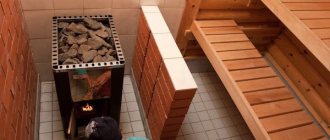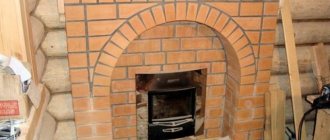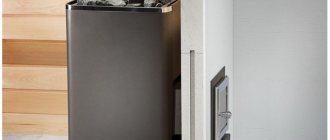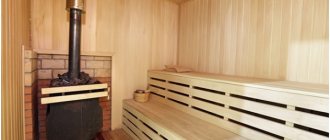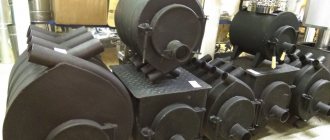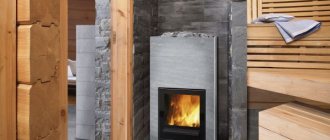Features of installing a brick screen yourself
Such protection for a metal stove is arranged in compliance with certain requirements to ensure the efficiency of the design.
Material selection
For masonry construction, it is recommended to use solid material that does not have void areas. The need for bricks is determined taking into account the size of the furnace and the additional area around it. You should also take into account the base for the stove, which will take from one to two full rows of bricks. If you plan to cover the stove on top and remove the chimney, this is also taken into account in the calculations. And lastly, decide how you will lay the bricks - half a brick or a quarter. All that remains is to make simple mathematical calculations and add a reserve stock of five to ten percent.
In order for the masonry to turn out to be of high quality, it is necessary to choose the right solution. Most often, ready-made masonry mixtures are used for arranging stoves, which are purchased at construction stores. They contain all the necessary components to maintain the integrity of the masonry during high heat. There is a second option - a clay-based solution.
Masonry mixture for arranging stoves
In addition, you will need a sheet of heat-resistant and waterproofing material, which will be laid under the base. As a rule, ordinary roofing material is used for these purposes.
If you plan to install an upper vault, prepare metal corners for the lintels along which the masonry will be laid.
Preparation and strengthening of the foundation
The base is first prepared, which must be sufficiently rigid and non-flammable. Roofing material is spread on the surface of the concrete screed, the base is laid out in one or two rows, which is given time to dry completely.
If the floor is wooden, you will have to dismantle some of the boards to build the foundation. In this case, part of the soil is removed, a cushion of sand and crushed stone is installed, formwork is installed and a concrete screed is poured over the reinforcement frame.
Stages of constructing a brick screen
The algorithm of actions is as follows:
- a container for water is being prepared in which we will soak the bricks for about thirty minutes;
- We mark using strong thread or fishing line. We will lay the masonry along this line;
- mix the required amount of mortar mixture;
- cover the heater with polyethylene to keep it clean;
- We start the row from the corner section, check the evenness of the laying of each stone, trim them, remove excess mortar. It is necessary to ensure that the suture areas are the same - within 7 mm;
- we start the second row from the same point as the first, but we start it with half a brick;
- When driving the third row, do not forget to leave a couple of holes in it for air circulation;
- the next five rows are displayed solid;
- When working near the fire door and ash pan, you must ensure that the bricks do not interfere with the opening of the doors in the future;
- in the top rows we again leave a couple of holes;
- To make the screen attractive, we perform cross-linking.
Arbitrage practice
Many enterprises tried to fight the requirements for widespread implementation of the SP in terms of determining hazard classes for each transport batch of waste. An attempt was also made by Gazprom Transgaz Ukhta LLC. In 2009, the company filed an application with the Supreme Court of the Russian Federation to challenge SP 2.1.7.1386-03″. The statement states that they were adopted by the Chief State Sanitary Doctor of the Russian Federation with excess of authority, do not comply with Articles 14, 20 of the Federal Law “On Production and Consumption Waste”, paragraph 1 of Decree of the Government of the Russian Federation of October 26, 2000 N 818, paragraph 5.3.7 Regulations on the Federal Service for Environmental, Technological and Nuclear Supervision, approved by Decree of the Government of the Russian Federation of July 30, 2004 N 401, and unlawfully impose on Gazprom Transgaz Ukhta LLC the responsibility for establishing the hazard classes of all waste generated by society, according to the degree of their toxicity .
However, the Supreme Court reviewed the case materials and found the application not to be satisfied. From clause 1.1 of the Sanitary Rules it follows that they were developed in accordance with Federal Law of March 30, 1999 N 52-FZ, Decree of the Government of the Russian Federation of July 24, 2000 N 554. Clause 2 of Article 51 of Law No. 52-FZ as amended in force on On the day of adoption of the joint venture, the Chief State Sanitary Doctor of the Russian Federation was vested with advising powers.
By virtue of paragraph 1 of Article 2 of this Federal Law, legal regulation in the field of waste management can be carried out by other laws and other regulatory legal acts of the Russian Federation. These include, in particular, the Federal Law “On the Sanitary and Epidemiological Welfare of the Population” and the Regulations approved by Resolution No. 554, in pursuance of which the Sanitary Rules were adopted. According to paragraph 1 of Article 14 of the Federal Law “On Industrial and Consumption Waste,” hazardous waste is divided into hazard classes in accordance with the criteria established by the federal executive authorities in the field of waste management in accordance with their competence.
Thus, the legislator stipulates that such federal executive authorities independently establish the criteria by which waste is divided into hazard classes. Sanitary rules, differentiating waste into four hazard classes, were introduced in order to establish and prevent the harmful effects of toxic waste on the environment and human health. Taking into account the above, the Sanitary Rules and other documents do not contradict. By decision of May 26, 2009 N GKPI09-385 of the Supreme Court, the application was rejected. In the future, judicial practice also develops mainly not in favor of natural resource users.
On the decision of the Moscow Arbitration Court dated August 12, 2013 in case No. A40-68900/13
During a scheduled on-site inspection, it was found that for various construction waste generated during technological processes and operation of buildings and structures, the enterprise has not determined and has not agreed with the institution exercising state sanitary and epidemiological control, the hazard classes of production and consumption waste for public health and the human environment, which is a violation of clause 2.10 SP 2.1.7.1386-03.
On May 8, 2013, an official of the Department drew up a protocol on an administrative offense against LLC “...” and issued Resolution No. 503 of May 21, 2013 imposing an administrative penalty. The Moscow Arbitration Court examined the evidence presented. Thus, from the stage of waste generation, a legal entity is responsible for determining the hazard classes of waste generated as a result of its economic activities and their coordination with the institution exercising state sanitary and epidemiological control in the relevant territory.
However, in the process of carrying out business activities, the Company did not ensure compliance with the above requirements. By decision of August 12, 2013, the Moscow Arbitration Court refused to satisfy the stated demands of LLC “...”, the applicant’s guilt was proven, confirmed by relevant evidence, materials of the administrative case and constitutes an administrative offense under Article 8.2 of the Code of Administrative Offenses of the Russian Federation.
How to make a protective screen for a sauna stove with your own hands
Rest assured that there is nothing difficult in creating a protective screen for a bathhouse with your own hands.
It is recommended to prepare all the necessary materials and tools in advance, as otherwise this will significantly slow down the progress of work. Having everything you need will help not only not to stop construction and installation, but also will not confuse the overall “engineering idea”.
Made of brick
Brick and concrete mixture are used as the main working material. Mixtures that are designed for use at high temperatures should be used. If you do not want to spend money on purchasing it, then you should add clay to the standard mixture. This will strengthen the future structure.
When calculating, it is necessary to take into account three parameters to determine the required amount of brick, namely:
Keep in mind that in the masonry it is necessary to calculate an additional few millimeters between the bricks for the concrete mixture.
- The manufacturing process is no different from laying bricks. All that needs to be done is to create a kind of brick “fence” around the stove of the required height.
- After installation, it takes at least 5-7 days for the solution to dry completely. A longer period is required due to the confined space - the solution dries worse in it.
- After completing the last stage of work, you should additionally check the strength of the masonry. If necessary, additional basalt slabs can be installed on top of the brick to provide greater security.
Made of metal
Metal structures are more durable, since this material can more easily withstand temperature changes. The complexity of installation and the price of such slabs are slightly higher than their brick counterparts.
The work will require sheet metal: zinc sheets or steel, as well as additional mineral insulating materials that are not subject to combustion and melting at high temperatures. A welding machine and sheet fastening mechanisms are also required.
The thickness of the insulating material should be at least two centimeters, and the height of the shield should be 5-10% greater than the height of the furnace. Remember that the wall of the structure is double, so eight sheets of metal are required to complete the job.
Step-by-step manufacturing instructions
- Prepare all necessary materials and consumables;
- Place the insulating material in an even layer on the sheet of metal;
- A second layer of metal is applied on top;
- Special fasteners are welded using a welding machine to hold the structure together.
- The produced sheets must be installed around the furnace on all sides using fasteners.
- It is recommended to place insulation under the bottom to prevent unintentional charring of the floor and fire in the room.
Waste management activities
Waste management includes activities related to the collection, accumulation, transportation, processing, disposal, neutralization and disposal of waste.
All of the listed types, except for waste accumulation, are specific. To carry out these types of waste management, it is necessary to obtain a license in accordance with Federal Law-89 and Federal Law-99. In the process of obtaining a license, one of the stages is to obtain from Rospotrebnadzor a sanitary and epidemiological conclusion on the compliance of the declared types of activities/works/services with state sanitary and epidemiological rules and regulations. During the examination of materials justifying such activities, Rospotrebnadzor always requests a calculation of the toxicity class of the waste (what is commonly called a “toxicity passport”). However, the accumulation of waste for a period of no more than 11 months is carried out by absolutely all users of natural resources who generate waste and who are not required to license this activity. Thus, ordinary offices, institutions, and small enterprises that transfer their waste to third parties and do not apply for a license are also required to determine the toxicity class for each transport shipment.
In previous years, Rospotrebnadzor was not particularly persistent in terms of universal compliance with paragraph 2.9 of the Rules, but now information appears about instructions to ordinary natural resource users about the need to eliminate violations of the law in this matter, not to mention those enterprises that received a license after once calculating the toxicity class of their waste and forgetting about it. Determining the toxicity of each transport batch is a financially expensive matter. In addition, Rospotrebnadzor and its subordinate centers of hygiene and epidemiology are directly involved in this. Their services are not cheap, and the work is not completed in one day, so temporary downtime in waste removal is inevitable.
Please note that paragraph 2.9 stipulates that it is not necessary to determine the hazard class of each transport batch of waste in the case of waste storage at landfills (storage sites) of the enterprise; in this case, the selection is carried out once every 3 years. But the fact is that the concept of “waste storage” is not legally enshrined; it is an outdated term, which is now similar to the term “disposal (storage, burial)”, and the period of placement now starts from 11 months, and not from 3 years
The definition of warehousing is only in GOST.
Thus, the lack of unity of terminology in environmental and sanitary legislation becomes the cause of abuse and excessive demands on natural resource users.
Protective screen for the stove in the steam room
A protective screen for a stove in a steam room can be made from more modern materials if you want it to be very beautiful. Now there are a lot of facing materials for any budget that can be used for screen construction:
- fired clay terracotta tiles
- clinker tiles: also made of clay
- natural soapstone: especially attractive for steam baths for its healing properties. On sale are square tiles of various sizes (300x300m or less), 10mm thick, polished or polished, rectangular bricks 20mm thick, looking like torn stone.
But you can’t just make cladding from this material on logs; you’ll have to build a base for the tiles. That is, first sheathe a wall with a ventilation gap of 2-3 cm with fire-resistant sheet material (and only then lay stone or tiles on it), such as:
- cement fiber board Minerit
- glass-magnesium sheet (GML)
- fireproof plasterboard (GKLO)
If you do not have high aesthetic demands on the protective screen for the stove in the steam room, then the easiest way is to sheathe the walls with the above gap with fire-resistant sheet material without further expensive tiling, such as vermiculite slabs, which, however, have a quite presentable appearance and have all the necessary qualities:
- environmentally friendly
- fire resistant
- fireproof
- easy to install
We can also recommend fiber cement board, which is a non-flammable material, can withstand temperatures of 150 degrees, does not emit harmful substances, is easy to clean and wash, does not rot and is resistant to fungi.
Conclusion: if you make a protective screen for a stove in a bathhouse with your own hands, then it is better to give preference to constructing a boundary wall made of bricks or lining the wooden walls of the steam room with vermiculite slabs.
When is protection needed at all?
The need to install protective casings and screens does not always arise. If a fire-safe distance is maintained between the stove and the nearest flammable surface, additional protection is not needed. At this distance, the IR rays are scattered, weakened, and the amount of them that the wooden wall receives can no longer lead to damage.
It is believed that the safe distance from the wall to the brick stove (quarter-brick laying) is at least 0.32 m, from the wall to the metal stove (not lined) - at least 1 m. For a metal stove lined from the inside with brick or fireclay, the distance decreases to 0.7 m.
Thus, maintaining fire safety distances is more possible in large baths, where the issue of saving space is not relevant. In family steam rooms, where every centimeter of space counts, installing a stove 0.3-1 m from the nearest walls is impractical. In this case, the safety distances established by the standards must be reduced using screens and casings.
Criterias of choice
Before installing protective screens in the bathhouse, it is necessary to choose the right design. The choice is influenced by a large number of different parameters - from the material from which the stove is made, its power, to the temperature regime and other factors.
To make the screen as effective and safe as possible, it is recommended to take into account the following parameters:
- level of heat resistance of the material,
- complexity of installation work for the structure being installed,
- resistance to wear and temperature changes, because the working conditions for screen elements are not considered the most favorable,
- the price of the material, which determines its effectiveness.
Protective screen for the stove in the steam room
A protective screen for a stove in a steam room can be made from more modern materials if you want it to be very beautiful. Now there are a lot of facing materials for any budget that can be used for screen construction:
- fired clay terracotta tiles
- clinker tiles: also made of clay
- natural soapstone: especially attractive for steam baths for its healing properties. On sale are square tiles of various sizes (300x300m or less), 10mm thick, polished or polished, rectangular bricks 20mm thick, looking like torn stone.
But you can’t just make cladding from this material on logs; you’ll have to build a base for the tiles. That is, first sheathe a wall with a ventilation gap of 2-3 cm with fire-resistant sheet material (and only then lay stone or tiles on it), such as:
- cement fiber board Minerit
- glass-magnesium sheet (GML)
- fireproof plasterboard (GKLO)
If you do not have high aesthetic demands on the protective screen for the stove in the steam room, then the easiest way is to sheathe the walls with the above gap with fire-resistant sheet material without further expensive tiling, such as vermiculite slabs, which, however, have a quite presentable appearance and have all the necessary qualities:
- environmentally friendly
- fire resistant
- fireproof
- easy to install
We can also recommend fiber cement board, which is a non-flammable material, can withstand temperatures of 150 degrees, does not emit harmful substances, is easy to clean and wash, does not rot and is resistant to fungi.
Conclusion: if you make a protective screen for a stove in a bathhouse with your own hands, then it is better to give preference to constructing a boundary wall made of bricks or lining the wooden walls of the steam room with vermiculite slabs.
Types of structures
To begin with, it is necessary to say that there are two types of similar structures that have a similar purpose and at the same time can perform different additional functions. Modern protective screens for sauna stoves quite often combine several different materials and are made in accordance with the design of the stove.
Taking into account these features, the craftsmen try to combine all the properties of similar products in order to achieve maximum results.
Full brick lining will allow for insulation around the entire perimeter of the device
Brick walls and trim
- Very often when creating ovens with their own hands, craftsmen resort to creating brick screens.
- Usually this is a partition that separates the metal product from the walls. It prevents the spread of infrared radiation to wooden surfaces and protects them from high temperatures that can lead to fire.
- The installation instructions also advise installing such structures between metal sauna stoves and the place where people will be. So intense radiation will heat the partition, which will play the role of an additional heater. However, it is worth remembering that when using a simple wall, you should leave a small air space.
The simplest brick partition can become an excellent screen
- Some craftsmen suggest immediately framing the entire sauna stove with a wall of brick or stone so that it can perform both tasks simultaneously. This way the structure will protect the walls of the room and prevent intense radiation from getting outside.
- It is worth noting that the screen for the sauna stove does not need to be used if the structure already has its own lining. This also applies to brick stoves, which actually themselves represent a firebox with thermal protection.
- For the manufacture of such structures, only red ceramic bricks or other materials with similar properties are suitable. The fact is that it tolerates moisture well and can withstand large temperature changes. Some craftsmen use special stones for this, which have low thermal conductivity and at the same time retain heat well.
Some craftsmen recommend simply sewing up the entire stove, which will give it a good appearance and help additionally retain heat.
Reflective surfaces
- Quite often, craftsmen recommend using a stainless steel screen for a bath. It should be noted that this metal must be perfectly polished and reflect infrared radiation.
- Such systems are usually used on back walls near stoves. They protect the surface from intense heating and at the same time redirect the heat inside the room. This allows you to reduce the cost of kindling and maintaining the regime.
Polished stainless steel screens
- Such heat-resistant screens for sauna stoves work very effectively even with brick stoves or when combined with stone partitions.
- Some manufacturers, making structures for heating baths, actively use them to improve the technical characteristics of their products. At the same time, professional craftsmen prefer to additionally mount bath screens made of stone or brick so that they absorb all the radiation, converting it into normal heating.
Screens with reflective surface
- Special attention is due to the fact that the metal also gets very hot and, if it comes into contact with wooden surfaces, can lead to a fire. That is why it is best to protect such a screen for a bath on the reverse side with heat-resistant material or create a small air gap.
- Quite often on sale you can see screens made of metal with a matte surface. Their price may be several times less, but they are less effective, and professional bath attendants claim that such screens are generally useless and only take up extra space.
- It is worth noting that such structures require periodic maintenance, since plaque and stains appear on them over time. To do this, they can be wiped with a special detergent or lemon juice.
Factory product made in the form of a fence
Materials
The protective screen serves not only as a barrier from a metal furnace, but also as protection for a nearby wall. If a brick oven is installed, such a device will not be required, because it itself is safe.
You can build a screen from a variety of materials, for example, mineralite, brick or galvanization.
Metal
Most often, the protective device in a sauna or steam room is made of metal or cast iron, but the casing can be made of stainless steel or heat-resistant tiles. This material is different in that it does not absorb heat, but, on the contrary, releases it into the room.
The partition around the stove can be either side or front. In any case, the distance between the nearest wall and the stove should not be less than 10 centimeters. The height of the shield should be slightly larger than the firebox.
Brick
As for the brick partition, it should be made 20 centimeters higher than the heating device. At the very bottom of such a wall, it is necessary to leave small gaps that will ensure the exchange of air between the stove and the protective screen. If necessary, these holes can be covered with doors.
The masonry of such a screen is most often made of fireclay bricks on a mortar made of clay and cement. As for the thickness of the protective structure, it should be made either half a brick or ¼ of it. But if the screen turns out to be too thin, then its level of thermal insulation will decrease significantly. The distance between the wall and the stove should not be less than 15 centimeters. The good thing about a brick screen is that it completely covers all surfaces of the stove and protects all surfaces in the room from fire. In addition, it is worth noting that a brick screen will look very nice in a steam room.
Tree
Wooden barriers are most often used as decorative handrails near the stove. In addition, such a screen will help protect bath attendants from getting burns. It will be better for the heater if the wooden screen is located at a distance of no less than half a meter from it. However, if such a structure darkens or even small stains appear on it, then it will need to be moved even further away from the stove to avoid fire. The height of this barrier depends on whether children will visit the bathhouse. If so, then the screen needs to be made higher so that they cannot get burned.
All the materials described above are perfect as a basis for creating a screen for a stove in a bathhouse. However, today many people prefer fire-resistant mineralite. After all, it has excellent characteristics. First of all, fiber cement board, as mineralite is also called, does not contain radioactive substances at all. In addition, it does not release lime. A protective partition made of such material does not need to be sheathed with anything additional. In addition, you can purchase this material at any hardware store. The only downside is that it doesn't look very nice.
How to protect the walls of a wooden bathhouse
If your bathhouse is brick, then the risk of fire is minimal and any stove can be installed flush against the wall. But many people prefer to build wooden baths: they are healthier, more comfortable and more economical. But it is no longer possible to place the stove close to the wall, since there is a high probability of spontaneous combustion of the wood.
Good protection for the walls of the bathhouse from the stove is the creation of a protective screen. Unlike complex options with replacing part of the outer wall or laying out the stove in the middle of the steam room, this is simpler and more convenient. Let's consider a heat-resistant screen for a convection-type sauna stove.
Heat-resistant screen for oven
Metal screens for the furnace are assembled from small hollow elements inside, such as boxes. They are framed with stainless steel or sheet metal painted with heat-resistant paint. It turns out that there is an air gap between two sheets of metal, which provides excellent thermal insulation, protecting wooden walls from extreme heat. The temperature that is established in such cases between the screen and the load-bearing wall is no longer sufficient for spontaneous combustion. There are holes at the bottom of the screen, the purpose of which is to create the necessary air circulation and prevent overheating of the steel sheets.
Metal screens for saunas made of polished metal reflect some of the heat back into the room
It is very simple to create such protective screens for sauna stoves with your own hands. The easiest option is to take a sheet of metal. It is better if it is polished - shiny surfaces reflect heat rays well, i.e. it turns out that part of the thermal radiation will be “deployed” into the room, and not absorbed by the metal.
Metal screens for bathhouses are easy to make with your own hands
You cannot attach metal directly to a wooden wall: it gets very hot, and due to its high thermal conductivity, it transfers heat well to the wood. Therefore, they take non-flammable strips of their material with low thermal conductivity, nail/screw them onto the wall, and metal is already attached to them. As a result, an air gap remains between the screen and the wooden wall. And one more nuance: the sheet is positioned so that there are several centimeters from the beginning of the metal to the floor. Then rising air currents will blow across the screen and take away most of the heat.
You can do it differently: lay a layer of thermal insulation on the wall (mineral wool, basalt wool, glass wool, etc.), and attach metal to it. In this case there will be no convection, but the wall will be protected from overheating. The thickness of the material depends on the characteristics of the selected thermal insulator. They fasten it again depending on the type. If it is a rolled material, make a sheathing, the distance between the slats of which is slightly less than the width of the material. Insulation is inserted between the slats. In principle, it should hold well without additional fasteners, but you can additionally secure it using special dowels with a large head. You can place a piece of something dense under a regular nail, but not metal or plastic. If the heat insulator is mineral wool cardboard or asbestos sheet, it can be attached directly to the wall, with a metal sheet on top.
Protecting the walls of the bathhouse from the stove can even be a decoration
What else can be used to make a heat-resistant screen for a furnace? Ceramic tiles look good and are easy to clean; artificial or natural stone looks great. You can lay a brick wall along a wooden wall. It is advisable then to take the same brick as for the screen (if you made one). Then the overall design will be in the same style. The cladding made of soapstone slabs or any other natural stone looks very beautiful, especially in combination with a similar lining of the stove. But such screens in bathhouses are rather an exception - the material is very expensive to decorate a bathhouse with.
DIY metal protective screen
Now let's see how to install a metal screen for a sauna stove with your own hands. The installation of such an element is usually carried out so that the structure resembles a box. The outside is made of stainless metal or steel sheet coated with heat-resistant paint. As a result, an air cushion is formed between the steel sheets, which helps to ensure reliable thermal insulation. Small holes are left in the lower parts of the structure to promote air circulation and prevent overheating of the iron box.
To make a protective screen for sauna stoves from metal, you will need a welding machine
Tools and materials
To work, you will need sheets of steel or stainless metal, a welding machine, an angle grinder with cutting wheels for metal, a drill, self-tapping screws, and non-flammable material.
Screen making
We choose a polished metal sheet that has better heat transfer. In most cases, such screens are installed on the back walls to prevent heat loss. You should not strengthen such protection directly on the wall - the likelihood of a fire increases several times. In order for the installation to be carried out correctly, it is necessary to place a layer of non-combustible material between the wall and the protective element so that there is free space for air behind the sheet.
Here it would be fair to note that a screen made of stainless material for a stove is much better than one with a matte surface, which serves its purpose worse.
Installation
Based on the thermal insulation material you have chosen, the arrangement of protective screen elements is carried out as follows:
- if rolled material is used, the cladding is done so that the gap between the slats is slightly smaller than the width of the material itself. The insulating layer is laid between the planks, fixed to the wall surface, a metal screen is attached,
- when it is decided to use mineral cardboard or sheet asbestos as a heat insulator, it is attached to the wall surface and then covered with a sheet of metal.
To maximize the effectiveness of protective screens, it is recommended to install a floor element that is placed under the stove.
Additional aspects
It is worth understanding that not all situations require a protective screen at all. For example, for brick kilns with an initially protected firebox, fences are not required. If the screen needs to be installed, then red ceramic materials are selected for it, capable of withstanding severe temperature changes and exposure to moisture.
Conclusion
A DIY sauna stove screen is an important sauna structure that can prevent accidental burns and balance the operation of the stove. By implementing one of the proposed schemes, you can achieve a combination of protection efficiency, good functionality of the stove and good visual qualities of the entire system.
Recommendations
When assembling protective screens, various difficulties may arise. To avoid them, you need to consider some recommendations:
- A gap of 3 cm must be left between the brickwork and the heating walls of the furnace. Otherwise, the brickwork will quickly crack from overheating and the pressure of the expanding metal.
- When mixing the solution, you need to choose components that are resistant to high heat.
- The protection, made of stainless steel, quickly loses its visual properties if the stove is fired very often. To preserve the appearance, you can coat metal surfaces with special paint or regularly wipe them with detergents.
By following these recommendations, you can make durable, effective protection for walls and floors from the heat of the stove.
Increasingly, metal stoves are being installed in modern baths. Their walls become very hot during operation, which negatively affects nearby surfaces of the room. To protect wooden walls from heat, you need to make a special screen. It can be made of metal and brick, combined with thermal insulation materials.
Common Mistakes
Improper shielding of metal furnaces
When creating and installing a structure on their own at home, novice craftsmen often make mistakes. Among them, the most common are:
- the lack of sufficient distance between the structure and the walls of the steam room negatively affects the strength of the masonry and fire safety;
- lack of distance between the walls of the furnace and the brick, which contributes to disruption of air exchange, overheating of the protective screen and cracking of the masonry;
- poorly mixed masonry mortar leads to crumbling of the masonry, the appearance of cracks and the formation of unnecessary gaps.
The technology for creating and installing a protective screen is quite simple. For this reason, even beginners in the construction business can handle it.
How to install a brick screen
- The heat shield for the oven is not placed close to the body. Calculate the space so that there is a distance of at least 3-10 cm between the wall of the heating unit and the brickwork.
- Be sure to make holes at the bottom. They serve to warm up the steam room faster at the initial stage. To be able to regulate the temperature in the steam room, you can equip these openings with stove doors. We opened the doors - heat flows into the steam room. Closed - the temperature does not rise. In the simplest case, you can close/open such a hole with a brick. But the doors, of course, look more attractive.
- The protective screen is placed in half of the brick. Some craftsmen lay bricks “on edge”, but this principle is not entirely justified: the wall turns out to be thin and heats up faster. Although, it all depends on what you want to achieve. If you are comfortable with a fairly high temperature, make a heat shield the size of a quarter of a brick or even with numerous windows. The heat will be somewhat milder, but it will still be hot. But it’s who wants what. For those who generally like low temperatures, we can advise making the screen as thick as a brick. Then the steam room will take a long time to warm up, but the screen will give off heat for a very long time. And being next to the stove will be much more comfortable.
- For masonry, a mixture of clay and sand is used. But if you don’t have clay, don’t worry: when laying out a heat-resistant screen for the furnace, you can use a cement solution. In many bathhouses, the screens are folded just like this and they don’t cost anything.
- The height of the brick wall around the stove cannot be lower than the upper surface of the firebox: the higher the screen, the better the protection. Some even lay stoves up to the ceiling. Although, this option has more disadvantages than advantages - the consumption of bricks is too high, a foundation is 100% necessary, and its feasibility is generally questionable.

